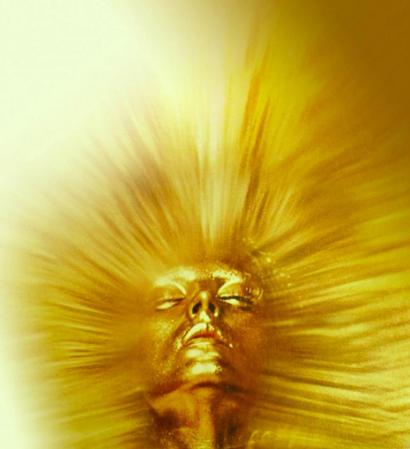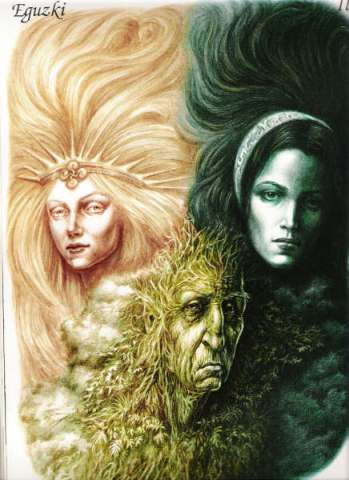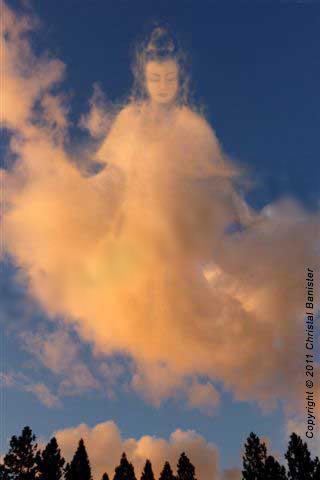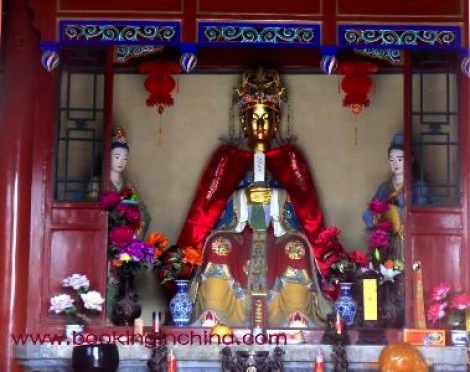
“Mawu” by Sandra M. Stanton
“Mawu’s themes are creativity, Universal Law, passion, abundance, birth, and inspiration. Her symbols are clay and the moon. Mawu arrives on an elephant’s back, expectant with spring’s creative energy. Hers is a wise passion and a timely birth, being ruled by natural laws and universal order. In Africa, She is a lunar-aligned creatrix who made people from clay. As a mother figure, Mawu inspires the universe’s abundance and every dreamers imagination.
Rituals for Mawu rejoice in Her life-giving energy, often through lovemaking. In Africa, people take this seed generation literally and sow the fields, knowing that Mawu will make the land fertile. So get yourself a seedling today and bring it into the house to welcome Mawu and Her creative powers. Name the sprout after one of Mawu’s attributes that you want to cultivate. Each time you water or tend the plant, repeat its name and accept Mawu’s germinating energy into your spirit.
Alternatively, get some non-hardening clay and begin fashioning a symbol of what you need. Devote yourself to spending time on this over twenty-eight days (a lunar cycle), until it’s complete. Each time you work, say:
‘Mother Mawu, make me whole
Help me obtain my sacred goal.’
By the time this is finished, you should see the first signs of manifestation.”
(Patricia Telesco, “365 Goddess: a daily guide to the magic and inspiration of the goddess”.)
In Dahomey mythology, Mawu, (pronounced MAH-woo) and sometimes alternatively spelled Mahu, is a West African Mother Earth creator Goddess associated with both the sun and moon. She is the Goddess of the night, of joy, and of motherhood as well as the ruler of the world’s wisdom and knowledge. She is the one who brings the cool nights to the hot African world. Sometimes She is seen as a moon Goddess, the twin sister-wife of the sun god Lisa (alternatively spelled Liza), but sometimes “She” is seen as one androgynous or hermaphroditic deity, Mawu-Lisa. Mahu and Lisa are the children of Nana Buluku, and are the parents of Xevioso. [1] [2] [3]

“Mawu and Lisa had fourteen children, seven sons and seven daughters, and they divided the responsibilities of the world among them. Mawu is also the Goddess of motherhood, since it was she that created the first humans out of clay, and she gives humans their souls.” [4]
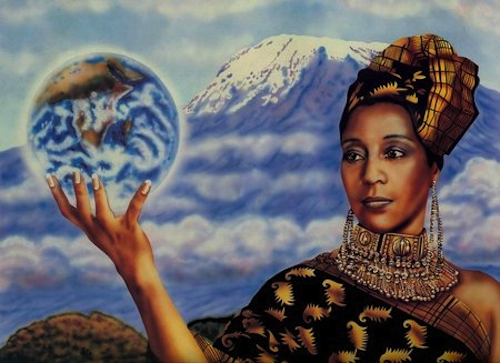
“Mawu” by Lisa Iris
“After creating the earth and all life and everything else on it, She became concerned that it might be too heavy, so She asked the primeval serpent, Aido Hwedo, to curl up beneath the earth and thrust it up in the sky. When She asked Awe, a monkey She had also created, to help out and make some more animals out of clay, he boasted to the other animals and challenged Mawu. Gbadu, the first woman Mawu had created, saw all the chaos on earth and told her children to go out among the people and remind them that only Mawu can give Sekpoli – the breath of life. Gbadu instructed her daughter, Minona, to go out among the people and teach them about the use of palm kernels as omens from Mawu. When Awe, the arrogant monkey climbed up to the heavens to try to show Mawu that he too could give life, he failed miserably. Mawu made him a bowl of porridge with the seed of death in it and reminded him that only She could give life and that She could also take it away.
This myth is similar to the Yoruba story of Yemaja and Aganju, parents of the Orishas.” [5]

“Mawu” by Lisa Hunt
In another version of Her story I read, “Mawu is said to have created all of the life on earth with Her husband, Liza, but after doing so, She worried that it might be too heavy…and so She called on the serpent Aido Hwedo for help. Legend has it that the serpent thus curled itself into a ball beneath the earth and pushed it up into the sky; Mawu then retired to the jungle realm of heaven and for awhile, all remained in peace and harmony.
But, before long, the people of the earth began to fight amongst each other….having forgotten that it was Mawu who had provided each of them with not only the world on which they lived, but also the essence of life, their souls. To fight each other was to fight Mawu as well. Mawu then sought aid from the monkey, Awe, who turned out to be an insolent braggart who boasted that he was just as powerful as She. He boasted that he, too, could make life…and when the people of Earth heard this, they began to believe him.
To prove it, he chopped down a tree and carved on it all the features of a person, and when he was finished, he stepped back and said that he had created a person. Mawu observed that wooden figure lying on the ground and remarked that the figured didn’t do anything and She challenged Awe to breathe life into it. Awe then gulped a tremendous breath of air and blew it strongly, but the person continued to lie still and mute on the ground. Once again he tried and this time, he blew so strongly that the wooden figure moved in the wind’s path, but it remained lifeless. After two more attempts, he admitted that he had been defeated and hung his head in shame, acknowledging that only Mawu could make life; he said that he would return to the world below and tell everyone that he had been wrong.
But, Mawu knew he really didn’t mean it, that he was a charlatan, and once he returned to earth, he would only start boasting again. So, She made him a bowl of porridge to eat before his long journey, and into this porridge She had put the seed of death. And only after Awe had finished eating did he learn of the seed he had eaten and would carry back to earth the knowledge that She and no other is the giver and taker of life.” [6]
Sources:
Andarta, Boudicca. PaganPages.org, “Mawu“.
MXTODIS123. An Inner Journey: The Moon, Mythology, and You, “Mawu“.
Sabrina. Goddess A Day, “Mawu“.
Wikipedia, “Mawu“.
Suggested Links:
Antoine Family Reunion. Antoine Family Reunion, “The Vodun Creation Story“.
Goddess. The Grateful Goddess, “Goddess of the Month ~ Mawu“.
Iles, Susan. Susanneiles.com, “The Dragon & Creation: Reclaiming the Sacred“.
The Goddess Temple, Inc. Talk with the Goddess, “Goddess Mawu“.
Moon, Tora. The Goddess Speaks, “Mawu – Goddess of Creation (Dahomey of West Africa)“.
Solarlottery.com, “Mawu-Lisa the Creators: An African Tale“.
West African Diaspora Mami Wata Vodoun, “Exploits of the Gods“.

